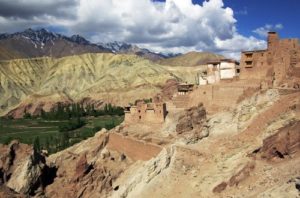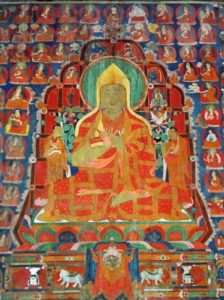Basgo was the capital of lower Ladakh until 1470 and a royal residence at different times between 15th and 17thC. The remains of the Palace walls and fortress stand high above village and include several Lhakhangs used by he Royal Family. It was an impregnable stronghold and resisted the forces of Tibet for three years.
Now the hillside has become very eroded. Locals were concerned the ruins would be lost and they began an initiative to stabilize and preserve the Palace and Gompa. They built a large mud brick restraining wall beneath the Chamba Lhakhang, using a human chain to pass the bricks up to the work face. The area is now being extensively restored with money from the World Monument fund.
The Gompa and Palace are reached along a side road which turns up a side valley and crosses a ford. Locals are still rebuilding the bridge washed away in the floods last year. There are good views of the ruins from the road.
The different parts of the site are reached by footpaths and many steps.
BASGO PALACE There is little left of the Palace which was built in the 11thC. The remains of walls include a long lower wall with the remains of pens for animals and ruined towers. There is no written history and little is known about the building.
BASGO GOMPA Chamba Lhakhang is built at the top of the hill and dominates the site. It is reached by a steep set of stairs and there are excellent views of the rest of the site and Basgo village from here.
The building is thought to be 15/16thC with the original wall paintings, which run those at Alchi a close second. Every available space on the pillars and ceilings are covered with paintings. Photographs are allowed and it is a photographers delight.
There is a huge statue of Buddha with two smaller Bodhisattvas. There are large paintings on the walls of the founder of the Red Hat Sect, Arhats and Buddhas. These are surrounded by small circles containing images of the different Bodhisattvas. Along the bottom of the wall is a frieze showing the different stages in life of Buddha including his early life. It is a beautiful painting with lots of detail. Around the top of the walls is another frieze representing the heavens with sun and moon and animal heads holding up yellow material which represents the umbrella protecting the world, with protector gods underneath.
The Serzing Lhakhang is lower down the hillside and is slightly older and smaller than the Chamba Lahakhang. It is very dark inside. It contains a huge statue of Buddha which is so big the head is hidden by the upper storey of the temple. The side walls are painted but hidden by glass fronted cabinets containing Holy Books.
The tiny Chan Chung temple is at the bottom of the site and is built at the end of a promontory with views down to Basgo and is the best place for taking pictures of the village and fields.
It was originally built as an Islamic shrine by the Muslim Baltistani wife of a local king and looks very different to other Ladakhi temples. It is surrounded by a veranda. The inside is dwarfed by a huge statue of Buddha with pictures of the protector gods on the walls, each in intricate detail. Below is a row of Mahasiddhas with Bodhisattvas below. On top surrounding the gods are images of the peaceful poets (listener and translator) who help spread Buddhism. Above the doorway is the image of a protector Buddha surrounded by three of his manifestations and a protector god in bottom left hand corner. There are images of the cardinal kings on either side. The main colours used are dark blues and reds with some yellows and white, so it is fairly dark inside.
This is a delightful place to visit. It is not on the tourist tick list and receives few visitors. This is a shame as the paintings in Chamba Lhakhang are among some of the best in Ladakh.
Our pictures are here.









